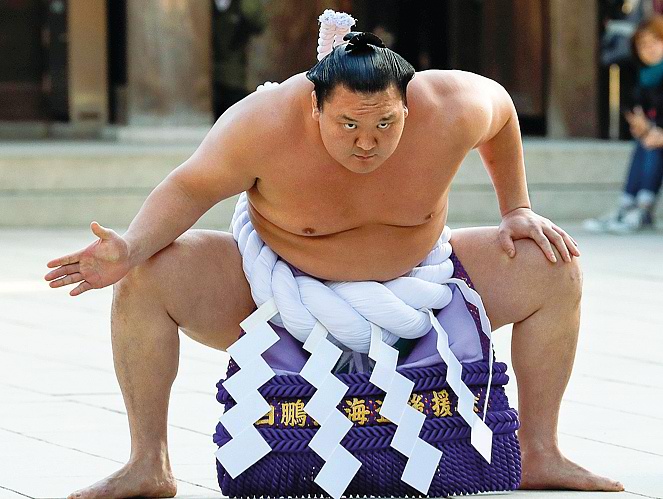Sumo wrestlers, the rikishi (力士), are very popular in Japan, they are real stars, but their life is far from simple. Almost everyone lives in the sumo school, called Heya, that welcomes them as children, at the age of 15, and that it remains their home for the duration of their racing career. Currently there are over 50 Heya distributed throughout Japan, but most of these are located near Tokyo. Each Heya is considered a small community in which up to 30 athletes live who live a life governed by criteria established by the Japan Sumo Association, and their violation can result in fines or suspensions. The maestro, Oyakata, he is usually a former top-level wrestler who has retired from competitive life and is the reference figure of the athletes: it is seen as a second father who provides for the maintenance of his boys by covering all their expenses and assigning them a small monthly salary.
Rikishi get up very early in the morning, at 6 the preparations begin and at 7 the actual training begins, theasa-geiko (morning training), do not eat breakfast because the exercises planned for the first hours of the day do not allow for good digestion. After training, which lasts three hours, and after cleaning the gym, they get together for lunch and then go straight to sleep to better assimilate the calories. Before dinner they can go out for a few free hours and the younger ones study and after dinner they go straight to sleep.
Despite the “chubby” appearance, the physique of the rikishi is a combination of fat mass and muscle mass, trained muscles that allow, in addition to the evident strength, also a marked agility and speed of movement. But what do they eat to have such a physique? The most important dish of their meals is the Chanko-nabe based on fish broth, chicken, tofu and vegetables, accompanied by a considerable amount of rice, ghoanand one or more glasses of beer.
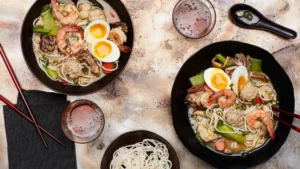
The weight of the wrestlers varies between 90 kg and 150 kg and is a fundamental element to have more chances of resistance against the opponent and win the match, but it is not the only main element to establish the category of each wrestler, it is also necessary that he is good at fighting.
The general ranking is called banzuke and is drawn up at the end of each tournament. Sumo wrestlers are divided into categories and are placed into one or another based on the number of matches they win during a tournament: the rikishi who wins eight out of fifteen matches can keep his rank. If he were to win less, he is forced to relegate; should he win more, he can advance one category.
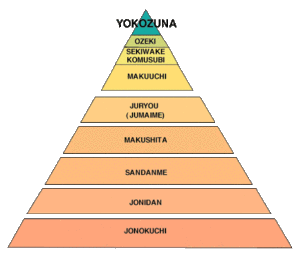 The highest category is that ofYokozuna (great champion), in which only the best wrestler ever falls, is the only category in sumo from which one cannot recede, a title that the wrestler retains until his retirement from the scene. The figure of Yokozuna she is respected almost as one deities by the Japanese and his entry into the dohyo is even more highlighted by the holding of the champion which obviously includes the loincloth called “mawashi” also the “tsuna” a choreographic and heavy braided rope. One Yokozuna he can earn as much as 3 million yen a month (about 30,000 euros).
The highest category is that ofYokozuna (great champion), in which only the best wrestler ever falls, is the only category in sumo from which one cannot recede, a title that the wrestler retains until his retirement from the scene. The figure of Yokozuna she is respected almost as one deities by the Japanese and his entry into the dohyo is even more highlighted by the holding of the champion which obviously includes the loincloth called “mawashi” also the “tsuna” a choreographic and heavy braided rope. One Yokozuna he can earn as much as 3 million yen a month (about 30,000 euros).
The only ones who receive a monthly salary are those in the second division and up. Second division wrestlers earn about a million yen a month. In addition, the winners of the most important matches of each day can receive up to 60,000 yen from sponsors. In addition to the basic salary, they also receive a bonus, called a mochikyūkin. This income is received six times a year. Special boosts to this bonus are also awarded for winning the Premiership championship. In addition to prizes for a championship, first division fighters who perform outstandingly can also receive one or more of three special prizes valued at 2,000,000 yen each. Being famous people, the most popular rikishi often become product endorsers and appear in numerous commercials and television programs, thus increasing their income.
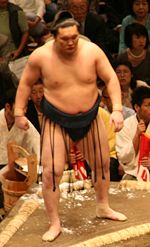
The only one garment that the Japanese wrestler is allowed to wear during training and during the fight is the traditional mawashi, il typical thong with a high waist belt obtained from a single long ribbon. It is impossible to be able to put on the thong alone and for this reason the wrestlers need someone to help them in dressing. The cloth ribbon is passed many times around the waist and between the legs of the athlete, to then be stopped with a knot behind the back.
The dressing as well as the choice of the color of the thong is a real ritual.
Many wrestlers, as well as the Japanese in general, are superstitious and each step must always be done the same way. If there was a defeat, the color of the thong must be changed before the next match!
The thong belt is used as a handhold to carry out grip techniques on the opponent and very often becomes an integral part of the strategy planned to embarrass the rival.
In fact, if the ribbon at the waist is left a little loose, the opponent, taken by surprise, may not find the right balance to drag the wrestler and therefore may overbalance himself until he falls to the ground.
Instead, the opposite strategy foresees that the thong is so tight as not to allow the opponent an immediate grip
However, the clothing varies according to the rank of the fighter, for example those who belong to the last two rankings can only wear a thin cotton tunic called yukata, and a black loincloth. Also, outdoors, he must wear a kind of wooden sandal called can. Fighters of the Makushita and Sandanme divisions may instead wear a traditional short overcoat over their yukata and straw sandals, called zori. Finally, those who belong to the first two categories have the best privileges, worthy of their positions: they can wear silk clothes of their choice and the quality of the fabric is considerably better, they wear their hair long and have it styled in a particular way in function of their importance in the Banzuke, the ranking.
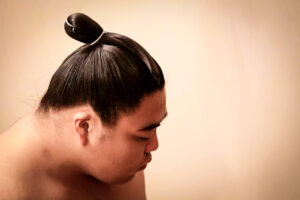 The particular way the wrestlers they style their hair does not go unnoticed.
The particular way the wrestlers they style their hair does not go unnoticed.
This. hairstyle is called Oi Chon Mage and it is a kind of tail in which the length of the hair, instead of being left free, is brought back to the top of the head.
This traditional, exclusively male hairstyle was a lot widespread in the Edo period.
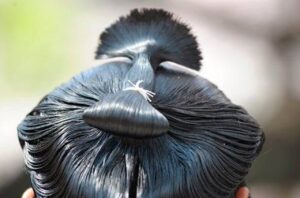
Only the high-level sumotorson the occasion of particular ceremonies, they can comb your hair in a more elaborate way.
After pulling the ponytail back to the top of the head, the tail of the ponytail creates a tuft open in a semicircle. According to tradition, it should remember a Ginkgo Biloba leaf. Such a hairstyle is called Oicho.
Since it is not easy to make this kind of hairstyles, the Japan Sumo Association finances and trains professional specifications hairdressing schools traditional able to cut, care for and style the hair of the wrestlers before each match.
The athlete will wear his hair thus styled from the day he is welcomed into one Heya until the end of his racing career.
At the time of withdraw from sporting activity, a solemn ceremony (Danpatsu Shiki) in which the main moment is precisely the cutting of Chon Mage.
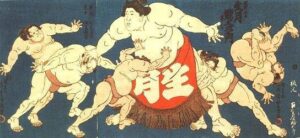 Ikuzuki Geitazaemon (1827-1850), at two meters twenty-seven centimetres, was the tallest sumo wrestler in history. Below is a representation of him from the time that renders the proportions well compared to his already gigantic colleagues. By way of comparison, the average height of adult Japanese males twenty years after his death was still five feet six.
Ikuzuki Geitazaemon (1827-1850), at two meters twenty-seven centimetres, was the tallest sumo wrestler in history. Below is a representation of him from the time that renders the proportions well compared to his already gigantic colleagues. By way of comparison, the average height of adult Japanese males twenty years after his death was still five feet six.
By Valeria Turino
